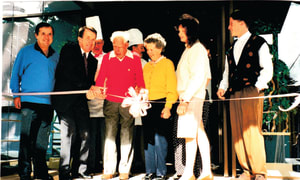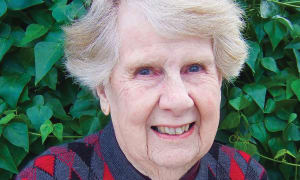
Jan Daff, pictured with her husband Geoff Daff (right) and brother Andrew Crole, who is following in the family tradition as captain of the Merinda on the Clyde River at Bateman’s Bay.
Saltwater in her veins
The ocean is in Jan Daff’s blood.
Her family has a long and fascinating history intertwined with the sea.
Her house in Newhaven sits in the heart of her family history, which includes a Newhaven shipbuilding industry and fearless Bass Strait fishermen.
Jan’s grandfather, Walter Harry Crole (known as Harry), moved to Newhaven in 1918, just after World War 1, when there were just three houses in the estate. With his wife Florence (Florrie) and five children, he carved out a lifetime connected to the sea. A successful fisherman, Harry was also an expert ship-maker, establishing a shipbuilding yard at the side of the family home.
“My grandfather, dad and uncle were among the first men to take up shark fishing in Bass Strait,” said Jan.
She describes her grandfather as an honest, intelligent and hard-working man, and a natural leader.
“The fishermen used to have meetings in a shed near the jetty, then Harry would meet with the council and help sort things out for the fishermen. He was even Shire President at one stage.”
Jan also remembers tales of the family spending winters in a makeshift camp at Wilsons Prom, so the men could fish all year around.
“They built huts and pitched tents at Refuge Cove, then when the easterly wind blew, the camp would pack up and move to Great Glennie Island.
“It was easier and much quicker to take the fish and crayfish to Port Welshpool than to battle the elements and bring them back to San Remo. Bass Strait can be a wild and dangerous body of water.”
Unravelling her family history has led Jan on her own voyage of discovery.
What started as a seemingly straight forward exercise in documenting her family’s achievements has billowed into an incredible story, complete with love, tragedy, heroics, loyalty and a passion for boats that spans the generations.
The stories could easily fill a book.
She fondly recalls spending time with her grandparents sitting between her grandmother and her tall stately grandfather for meals.
“Nanna was incredible. She taught me all the card games I know,“ smiled Jan.
“There was no power in Newhaven in those days, but Nanna was capable and very strong. She was always cooking on a big combustion stove. There used to be lots of people for meals at their house and Nanna would serve up dinner on their big table.”
Although it is hard to imagine a shipbuilding yard in amongst the beautiful houses on the Newhaven foreshore today, Jan says the family was still building boats there when she was growing up.
“At that stage, they were building boats on land down near the jetty. I still remember the smell of the ship yard, and the vapour from the timbers being steamed to bend and shape them.”
The boats made in the Crole shipyard are a part of the Island’s history, and integral to Jan’s family story.
“The boats were hand-made, not mass produced like most boats these days. Each one was unique. “That kind of ship-building is a dying art,” said Jan.
There’s a story behind every boat and they are practically part of the family. Jan talks about the boats as if they are living and these beautiful vessels often had fascinating lives.
The “Alacrity” built in 1939 by Harry and his sons, was launched with great fanfare, attended by hundreds of people.
During World War II, the boat was purchased by the American Navy and was sunk in the waters of New Guinea during a Japanese aerial attack.
Several of the other boats are still in use today, including the “Island Star” which now resides in Hobart.
“She was bought by the Commodore of the Royal Hobart Yacht Club and used as a starter boat. My brother took her to Hobart.”
Jan’s father’s favourite boat was the “Caraid”, which these days works in Vanuatu as a passenger charter boat.
The family is also renowned for their Phillip Island Ferry service.
With the Island facing a summer without a ferry, Harry travelled to Lakes Entrance to collect one.
The family ran the Island ferry service for 25 years.
She remembers spending many hours on the ferry as a child, going to work with her father Mervyn.
“We’d pretend to be driving the ferry, and sometimes we’d be allowed to go down into the engine room and watch the big Gardiner ticking over,” recalled Jan.
“The Eagle Star was Dad’s pride and joy. Over summer the ferry ran seven days a week. The men at the front bar of the Isle of Wight used to set their clocks by the ferry timetable!
“One summer in the 70s, I even ran the ferry canteen. I actually met my husband Geoff on board,” Jan laughed.
“He bought a sandwich from me and I thought, ‘ooh, he’s a bit of a spunk’!”
Jan’s two brothers, Reg and Andrew both fished in Bass Strait and worked for their dad on the ferry.
“Andrew is still running a ferry in Batemans Bay, along the Clyde River. They call him the King of Clyde.”
After travelling and working in Melbourne, Jan and her husband returned to the Island, where she has lived for the last 46 years.
In 2010, she and Geoff moved to a site in Newhaven that is steeped in family history.
“Originally, this was the site of a Tea House owned by the Cleelands,” explained Jan.
“I think they sold it to my Uncle Sydney and my parents bought it from Sydney.”
With a view out over the sparkling waters of Westernport, Jan sees her family history in motion every day.
“Our whole family is connected to the sea. This really is a life-long passion.”





